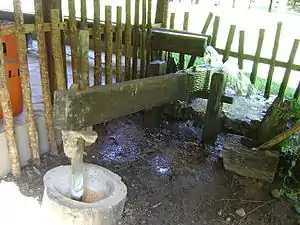Monjolo
A monjolo is a primitive hydraulic machine, used for the processing and grinding of grains. It was introduced in Brazil by the Portuguese during the colonial period.[1]

It can be used to peel and grind dry beans, resulting in a thicker flour.[2]
It is formed by a wooden beam suspended so that the part that supports the pestle is larger than the other, which ends with a trough. A spout fills the trough with the water, thus raising the pestle. When the trough is full, it lowers the trough, and when the trough spills the water, the beam falls, causing the pestle to hit the mortar. As such, the monjolo is an important tool for agricultural facilitation.
It is common for rural people to seek to live near a river or stream as a source of water. The monjolo is considered one of the most useful machines for planters of multiple crops.[3]
See also
References
- Monjolo Equipamento rústico para moagem de grãos custa 200 reais, economiza energia, funciona bem e tem vida longa por Gustavo Laredo - Revista Globo Rural
- A História do Uso da Água no Brasil: Do descobrimento ao Século XX, um projeto da Agência Nacional de Águas, 2007
- "O Monjolo e o Pilão por Angelo João Zucconi, editor do projeto TerraBrasileira.net". Archived from the original on 2008-02-18. Retrieved 2017-04-29.